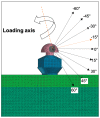Effect of Different Head Hole Position on the Rotational Resistance and Stability of Orthodontic Miniscrews: A Three-Dimensional Finite Element Study
- PMID: 34070904
- PMCID: PMC8198358
- DOI: 10.3390/s21113798
Effect of Different Head Hole Position on the Rotational Resistance and Stability of Orthodontic Miniscrews: A Three-Dimensional Finite Element Study
Abstract
The orthodontic miniscrew is driven into bone in a clockwise direction. Counter-clockwise rotational force applied to the implanted miniscrew can degrade the stability. The purpose of this three-dimensional finite element study was to figure out the effect of shifting the miniscrew head hole position from the long axis. Two miniscrew models were developed, one with the head hole at the long axis and the other with an eccentric hole position. One degree of counter-clockwise rotation was applied to both groups, and the maximum Von-Mises stress and moment was measured under various wire insertion angles from -60° to +60°. All Von-Mises stress and moments increased with an increase in rotational angle or wire insertion angle. The increasing slope of moment in the eccentric hole group was significantly higher than that in the centric hole group. Although the maximum Von-Mises stress was higher in the eccentric hole group, the distribution of stress was not very different from the centric hole group. As the positive wire insertion angles generated a higher moment under a counter-clockwise rotational force, it is recommended to place the head hole considering the implanting direction of the miniscrew. Clinically, multidirectional and higher forces can be applied to the miniscrew with an eccentric head hole position.
Keywords: implantation angle; miniscrew head hole; wire insertion angle.
Conflict of interest statement
The authors declare no conflict of interest.
Figures










Similar articles
-
The ideal insertion angle after immediate loading in Jeil, Storm, and Thunder miniscrews: A 3D-FEM study.Int Orthod. 2020 Sep;18(3):503-508. doi: 10.1016/j.ortho.2020.03.003. Epub 2020 May 6. Int Orthod. 2020. PMID: 32387220
-
Finite element analysis of miniscrew placement in mandibular alveolar bone with varied angulations.Eur J Orthod. 2015 Feb;37(1):56-9. doi: 10.1093/ejo/cju006. Epub 2014 Aug 1. Eur J Orthod. 2015. PMID: 25086029
-
Effects of placement angle and direction of orthopedic force application on the stability of orthodontic miniscrews.Angle Orthod. 2013 Jul;83(4):667-73. doi: 10.2319/090112-703.1. Epub 2012 Dec 14. Angle Orthod. 2013. PMID: 23241005 Free PMC article.
-
Influence of insertion depth on stress distribution in orthodontic miniscrew and the surrounding bone by finite element analysis.Dent Mater J. 2021 Sep 30;40(5):1270-1276. doi: 10.4012/dmj.2020-400. Epub 2021 Jun 30. Dent Mater J. 2021. PMID: 34193725
-
Effects of mechanical vibration on miniscrew implants and bone: Fem analysis.Int Orthod. 2019 Mar;17(1):38-44. doi: 10.1016/j.ortho.2019.01.022. Epub 2019 Feb 13. Int Orthod. 2019. PMID: 30770332
References
-
- Mo S.S., Noh M.K., Kim S.H., Chung K.R., Nelson G. Finite element study of controlling factors of anterior intrusion and torque during Temporary Skeletal Anchorage Device (TSAD) dependent en masse retraction without posterior appliances: Biocreative hybrid retractor (CH-retractor) Angle Orthod. 2020;90:255–262. doi: 10.2319/050619-315.1. - DOI - PMC - PubMed
-
- Antoszewska-Smith J., Sarul M., Łyczek J., Konopka T., Kawala B. Effectiveness of orthodontic miniscrew implants in anchorage reinforcement during en-masse retraction: A systematic review and meta-analysis. Am. J. Orthod. Dentofac. Orthop. 2017;151:440–455. doi: 10.1016/j.ajodo.2016.08.029. - DOI - PubMed
MeSH terms
LinkOut - more resources
Full Text Sources
Research Materials

